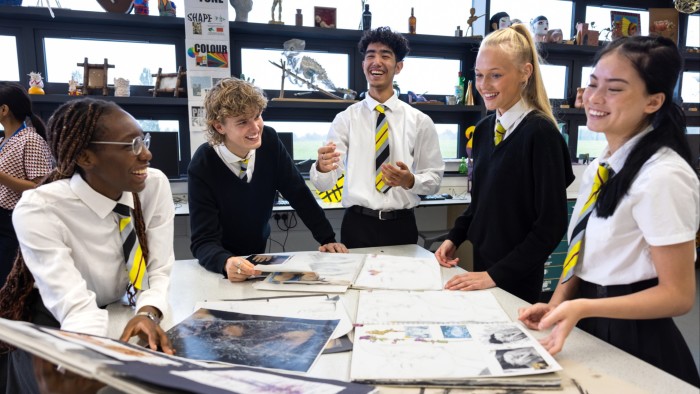The writer is the author of ‘Uncharted: How to Navigate the Future’
I have recently started hearing a new complaint from employers: that their workers are not free thinkers.
One said the highly educated graduates they hired from top universities were “well-credentialed and present effectively” and “excellent at taking instruction”. But the employer was concerned: “They don’t think for themselves. So I worry about them. I don’t know what they’ll be able to do when they’re 35.”
At first I thought the issue was workplaces. But that isn’t it. Employers in fields from finance to advertising, technology to medicine, are deeply concerned for bright, ambitious young people, whose prospects appear constrained by an education too tightly fitted to yesterday and not adaptable enough for tomorrow.
When I spoke to Michael Spence, president of University College London, he knew exactly where the problem lay: criterion-based assessment. This teaching method, familiar to most students in exam-based testing, judges work according to pre-determined criteria. It assumes, Spence says, “that the assessors know that one right answer. That is rarely true of real life.”
Students intuit what the system wants and become good at delivering it, studying only what the exam requires and marshalling well-rehearsed arguments.
But this is not what employers value now. It is not following instructions that matters but the ability to imagine and judge an array of options and alternatives. This requires curiosity to keep the mind well stocked, initiative to think beyond obvious agendas, resilience when answers are not obvious and a love of learning to power new skills.
Why have so many educationally accomplished individuals not learnt to think this way? In many instances, their education is too specific, too early. A focus on incentives such as grades or university places discourages discursive thinking. Undergraduates I have worked with want handrails and instructions detailed to the point of what font they should use.
In both the US and UK, enrolment in arts subjects is falling, in favour of science, technology, engineering and maths. Students flocking to these subjects may hope to gain the kind of “hard skills” valued by employers. But by ditching the arts, they are missing out on developing traits that may be more vital.
Poetry, for example, teaches us to explore ambiguity and think through different interpretations of language. Painting teaches us to discover and experiment. All art teaches us to strive for originality. These are just the aptitudes CEOs complain they cannot find.
This is not the case everywhere. In Singapore, educationalists have worried their high-achieving schools produced students who were more like machines accepting a download than real thinkers. Using an approach called “Teach Less, Learn More” schools began to relax timetables to allow more space for art and music, for students to choose a broader range of subjects and work more collaboratively. The reforms were designed to encourage curiosity and experimentation — something policymakers hoped would boost economic growth.
When Pisa, the Programme for International Student Assessment, began measuring how countries developed creativity — defined as the “capacity to produce original and diverse ideas” — in 2022, Singapore came close to the top of the list. The UK and US chose to opt out of the modules that measured these skills. They shouldn’t have: according to the National Foundation for Education Research, communication, collaboration and creativity will by 2035 be among the most prioritised skills in Britain’s labour market. This year the World Economic Forum’s Future of Jobs report argued analytical and creative thinking were already essential aptitudes.
This may explain why the arts, and other creative approaches to learning, are beginning to appear in executive education. At Oxford’s Saïd Business School, Rob Poynton teaches improvisation as a way to listen better and to break out of routines. Executives also benefit from the methods of Richard Olivier, who for years has used Shakespeare to prepare students for that essential leadership skill: moving into the unknown.
I was sceptical about this until I talked to Gates Foundation participants who said Henry V had offered them a safe way to consider leadership in action. What kind of leader will Henry become; what kind of leaders did they need to be? The story provides a mirror, Olivier says, where people can consider their own actions, and an illuminating remove.
Thinking about art can also help make your physician a better doctor. In an experimental programme at Yale School of Medicine, instructors asked aspiring medics to study paintings with limited contextual information and only open-ended questions. These students demonstrated greater observational rigour and made fewer mistakes than those following traditional training methods.
Learning to draw can also help with observational skills and adaptability. In 2022, I watched executives take part in pastel drawing workshops. They found they noticed more but also confronted their own impatience and competitiveness, realising how both interfered with concentration.
In an age of uncertainty, we can’t predict the specific profile of a productive workforce. But recruiting according to immediate demands risks becoming anachronistic fast. The focus has turned to broader skills and aptitudes: the ability to invent not copy, to imagine a multitude of scenarios, to collaborate with diverse perspectives, to be resilient and adaptable.
These traits are as likely to be found in arts graduates as those specialising in science, technology, engineering and maths. It is time for the liberal arts to come out of the cold.
